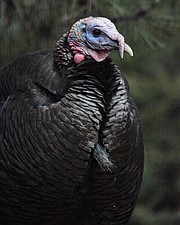A gob of turkey hunting opportunities in the Panhandle
Mild winters and snow accumulation in spring are a couple of factors that North Idaho turkey hunters ponder as the spring season approaches.
And the season is within shooting range.
Youth turkey season opens in a week, on April 8, and the general turkey season opens April 15.
Because of the lack of snow, hunters should be able to access rural turkey areas without using four wheel drive and they should find stellar bird numbers.
“Relatively mild winter helped birds survive in good numbers in most of the state,” Brian Pearson, of Idaho Fish and Game said. “Growing turkey populations and expanded hunting opportunities should make for a good to very good spring turkey season.”
Although numbers have been increasing across the state, which has resulted in expanded tags and bag limits over the past decade, the best turkey hunting remains in the old haunts.
The top turkey producers include units in the Panhandle, Clearwater, Southwest and Southeast regions that have a lot of public land and relatively easy access.
Those units Pearson said, have general hunts while most other areas in Idaho are limited to controlled hunts.
Panhandle hunters should strike out for lower to mid elevation areas near food and water and away from deep cover.
Although units 1 through 5 have traditionally been the Panhandle’s go-to turkey units, hunting units 7 and 9 opened this year to spring turkey hunting.
In spring, hunters can fill two, gobbler-only turkey tags.
“Only bearded turkeys may be harvested,” Micah Ellstrom, Panhandle region wildlife manager said.
Last year the department enrolled thousands of acres in a program called the Large Tracts Program that opens land to hunters. The properties can be viewed on the Idaho Fish and Game website.
“Lower elevations are quickly becoming snow free and are beginning to green up,” Ellstrom said.
Hunters who want to travel to the Clearwater Region — one of the first turkey hunting regions to open in Idaho after the birds were introduced more than 40 years ago — may consider the Craig Mountain Wildlife Management Area south of Lewiston. It has traditionally been a solid turkey hunting destination.
Clearwater populations over the past five years have been at or above the long-term average, biologist Dave Koehler of IDFG’s Clearwater Region said.
“Mild winter conditions were prevalent across the region this year,” Koehler said. “This should lead to easier access to higher-elevation portions of the region, but as always, access will also be dependent on weather and snowmelt between now and the opener.”
Hunters can find birds in forested areas with the highest densities found along the Clearwater River to the confluence of the Lochsa and Selway rivers, the Snake River drainage up the confluence with the Salmon River, the lower Salmon River drainage up to White Bird, and the Dworshak Reservoir area.
The IDFG Hunt Planner on the department’s website is a good tool for showing different federal land ownership. For information on corporate timberland, visit websites for the Potlatch Timber Corporation and the Bennett Lumber Company.



